𝐏𝐫𝐨𝐩𝐡𝐞𝐭 𝐌𝐮𝐡𝐚𝐦𝐦𝐚𝐝’𝐬 𝐍𝐢𝐠𝐡𝐭 𝐉𝐨𝐮𝐫𝐧𝐞𝐲 𝐓𝐨 𝐀𝐥-𝐌𝐚𝐬𝐣𝐢𝐝 𝐀𝐥-𝐀𝐪𝐬𝐚 – 𝐓𝐡𝐞 𝐅𝐚𝐫𝐭𝐡𝐞𝐬𝐭 𝐌𝐨𝐬𝐪𝐮𝐞 𝐢𝐧 𝐉𝐞𝐫𝐮𝐬𝐚𝐥𝐞𝐦 – 𝐄𝐱𝐢𝐬𝐭𝐞𝐧𝐜𝐞 𝐎𝐟 𝐌𝐚𝐬𝐣𝐢𝐝 𝐀𝐥-𝐚𝐪𝐬𝐚 𝐃𝐮𝐫𝐢𝐧𝐠 𝐈𝐬𝐫𝐚’ 𝐖𝐚𝐥 𝐌𝐢𝐫𝐚𝐣
Mohamad Mostafa Nassar
Twitter:@NassarMohamadMR
1. Introduction
𝐀𝐥𝐥𝐚𝐡 𝐄𝐱𝐚𝐥𝐭𝐞𝐝 𝐇𝐞 𝐢𝐧 𝐭𝐡𝐞 𝐆𝐥𝐨𝐫𝐢𝐨𝐮𝐬 𝐐𝐮𝐫’𝐚𝐧 𝐂𝐨𝐧𝐟𝐢𝐫𝐦𝐬 𝐭𝐡𝐞 𝐏𝐡𝐲𝐬𝐢𝐜𝐚𝐥 𝐍𝐢𝐠𝐡𝐭 𝐉𝐨𝐮𝐫𝐧𝐞𝐲 𝐨𝐟 𝐏𝐫𝐨𝐩𝐡𝐞𝐭 𝐌𝐮𝐡𝐚𝐦𝐦𝐞𝐝 𝐩𝐞𝐚𝐜𝐞 𝐛𝐞 𝐮𝐩𝐨𝐧 𝐡𝐢𝐦 𝐟𝐫𝐨𝐦 𝐌𝐞𝐜𝐜𝐚 𝐭𝐨 𝐉𝐞𝐫𝐮𝐬𝐚𝐥𝐞𝐦
Glory be to the One Who took His servant ˹Muḥammad˺ by night from the Sacred Mosque to the Farthest Mosque whose surroundings We have blessed, so that We may show him some of Our signs.1 Indeed, He2 alone is the All-Hearing, All-Seeing.” Quran (17:1)


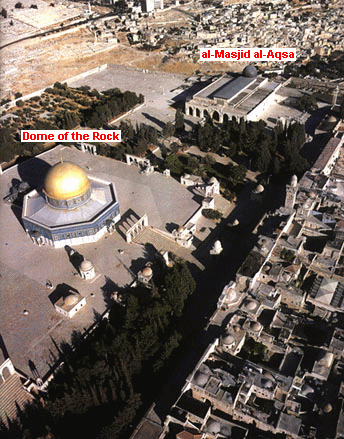

The Anti-Islamic Allegations:
Many Christian missionaries point to an alleged difficulty concerning the above passage. They claim that :
The Farthest Mosque (Al-Masjid-ul-Aqs-a) was built many years after the death of Muhammad. It is utterly impossible that Muhammad visited it on his Night Journey.
They further add :
The Temple of Solomon had been completely destroyed in 70 AD, i.e. 550 years before the alleged time of the Miraj in 622 AD, the twelfth year of Muhammad’s mission. A Temple that didn’t exist anymore does not provide any better solution to this problem than a Mosque which wasn’t built yet.
𝐒𝐢𝐦𝐢𝐥𝐚𝐫𝐥𝐲, 𝐭𝐡𝐞 𝐂𝐡𝐫𝐢𝐬𝐭𝐢𝐚𝐧 𝐚𝐩𝐨𝐥𝐨𝐠𝐢𝐬𝐭 𝐀𝐛𝐝𝐚𝐥𝐥𝐚𝐡𝐀𝐛𝐝 𝐚𝐥-𝐅𝐚𝐝𝐢 𝐬𝐚𝐲𝐬:
Moreover, the Further [sic!] Mosque was not in existence at the time of Muhammad, but was built about a hundred years after his death! How could he have prayed in it, then, or described its gates and windows?[1]
Firstly: al-Aqsa mosque was built not “about a hundred years” after the death of the Prophet in 11 AH / 632 CE. In 49-50 AH / 670 CE, Bishop Arculfus, a Christian visitor in Jerusalem, reported:
On the famous place where once stood the temple, the Saracens worship at a square house of prayer, which they have built with little art, of boards and large beams on the remains of some ruins…[2]
By the time Bishop Arculfus was in Jerusalem, some 40 years after the death of Prophet Muhammad, the al-Aqsa mosque was already being used as a place of worship by Muslims.
Secondly, as usual, the solution to such a “difficulty” lies in part in an elementary knowledge of the Arabic language as well as an understanding of basic Islamic concepts relating to the word “masjid”.
𝐓𝐡𝐞 𝐑𝐞𝐬𝐩𝐨𝐧𝐬𝐞:
𝟐. 𝐖𝐡𝐚𝐭 𝐈𝐬 𝐀 𝐌𝐚𝐬𝐣𝐢𝐝?
We will begin by dealing with the word masjid from both linguistic and legal points of view. The Arabic word for “mosque” is masjid. Discussing the word masjid from a linguistic point of view al-Zarkashi says:
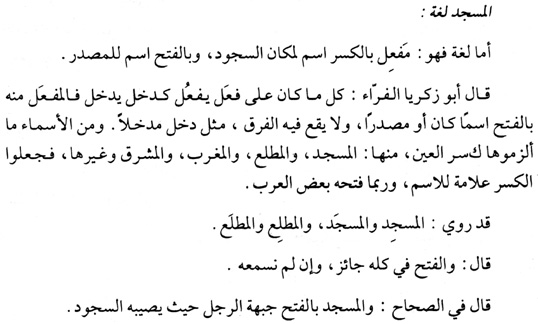

𝐌𝐚𝐬𝐣𝐢𝐝 𝐟𝐫𝐨𝐦 𝐚 𝐥𝐢𝐧𝐠𝐮𝐢𝐬𝐭𝐢𝐜 𝐩𝐨𝐢𝐧𝐭 𝐨𝐟 𝐯𝐢𝐞𝐰
Linguistically, it comes on the scheme of maf`il with a kasrah [i.e. the ‘i’ of masjid] which is ism makan [i.e., name of location] for prostration, while with a fathah [i.e., masjad] it is a masdar.
Abu Zakariyya al-Farra’ [a famous grammarian] said: Every verb coming on the scheme of fa`ala [in the past form] yaf`ulu [in the present form] like dakhala yadkhulu [which means “to enter”] admits the form maf`al with a fathah as a noun or masdar without distinction like in dakhala madkhalan. There are some nouns that were bound to take a kasrah on the second letter of its root like masjid, matli`, maghrib, mashriq and others, thus making the kasrah a sign of the noun, and some Arabs may say it with a fathah.
Indeed, masjid and masjad, and matli` and matla` were all narrated.
He said: Putting a fathah in all these forms is admissible even if we did not hear it before.
He said in Al-Sihah: Masjad with a fathah refers to one’s forehead which is the place involved in prostration.[3]
The Arab grammarians classify masjid as “ism makan“, i.e., “name of location”; it indicates the place where an action takes place. Masjid being derived from the root sa-ja-da (to prostrate), it means “place of prostration”. Since a place of worship is a place where believers prostrate to God, “masjid” is a general term to designate any place of worship without any religious distinction. Later, this word was used to designate Islamic places of worship in particular, i.e., the mosques.
The Prophet’s night journey was from “the inviolable place of worship” (al-Masjid al-Haram) to “the farthest place of worship” (al-Masjid al-Aqsa). The former is certainly located in Makkah, but what about the latter? The reference to Allah blessing its surroundings (… whose precincts We did bless) suggests a location in the “Holy Land” (cf. 21:81; 7:137; 34:18). Neal Robinson states:
The [Muslim] tradition which identifies it [i.e., al-Masjid al-Aqsa] with the Temple Mount in Jerusalem makes admirable sense in view of the fact that the ‘place of worship’ (masjid) whose destruction is evoked in v. 7 [i.e., 17:7] is clearly the Temple.[4]
𝐓𝐡𝐢𝐬 𝐯𝐢𝐞𝐰 𝐢𝐬 𝐚𝐥𝐬𝐨 𝐬𝐡𝐚𝐫𝐞𝐝 𝐛𝐲 𝐦𝐚𝐧𝐲 𝐰𝐞𝐬𝐭𝐞𝐫𝐧 𝐬𝐜𝐡𝐨𝐥𝐚𝐫𝐬.[𝟓]
As it was mentioned earlier that masjid refers to a place of prostration without any religious distinction; an excellent example of the usage of the word “masjid” referring to a non-Islamic sanctuary can be seen in the verse 17:7. The verse describes briefly the destruction of the masjid in Jerusalem (i.e., the Temple) by the enemies of Children of Israel. Allah says in the Qur’an that the destruction of the Temple in Jerusalem was a punishment was inflicted upon the Children of Israel for their tyranny and arrogance.
Now that the linguistic issues are clarified, let us now turn to the legal issues (i.e., Islamic Law) concerning the word masjid. Al-Zarkashi says:
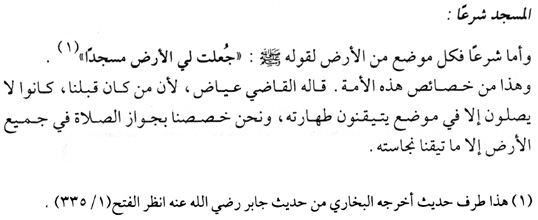

Masjid from a legal point of view
From a legal point of view it refers to every place on earth since the Prophet – peace be upon him – said: “The earth was made a masjid for me” which is a particularity of this ummah. This was said by the Qadi `Iyad because the previous nations used not to pray except in the places they were sure of their pureness whereas we were allowed to perform the prayers in any place not known to be impure.[6]
Further, he emphasizes:

Since prostration is the most honourable act in prayer because of the nearness of the servant to his Lord, the name of the location was derived from it. This is why we call it masjid [location of sujud / prostration] and not marka` [place of ruku` / inclination].[7]
In summary, masjid from a linguistic point of view means a “place of prostration” without any religious distinction. From a legal point of view the word masjid in shari`ah constitutes every place on earth that is fit for prostration. In other words masjid does not designate a building but only a “place of prostration”; the place may or may not have the building. In support of the argument, we quote hadith #323 in Sahih al-Bukhari that has already been mentioned by al-Zarkashi:

Muhammad Ibn Sinan, i.e., al-`Awqi told us, Hushaym told us; and Sa`id Ibn an-Nadr told me, Hushaym informed us that Sayyar informed us, Yazid, i.e., Ibn Suhayb al-Faqir told us, Jabir Ibn `Abd Allah told us:
The Prophet, peace be upon him, said, “I have been given five things which were not given to any amongst the Prophets before me. These are:
1. Allah made me victorious by awe [by His frightening of my enemies] for a distance of one month’s journey.
2. The earth has been made for me [and for my followers] a “masjid” [Arabic: a place for prostration]and a means of purification. Therefore, my followers can pray wherever the time of a prayer is due.
3. The booty has been made halal [lawful] for me [and was not made so for anyone else].
4. Every Prophet used to be sent to his nation exclusively but I have been sent to all mankind.
5. I have been given the right of intercession [on the Day of Resurrection].[8]
So, according to this hadith, any place on the earth is a masjid for Muslims. Therefore, whether there was a building or not when the Prophet made his heavenly trip, it is the location of the “Farthest Mosque” that is intended by the verse and not a building per se because the location where it lies was blessed by God as mentioned in verse 17:1 “the Farthest Mosque, whose precincts We did bless“.
Therefore, no one can claim that the word “masjid” in Islamic terminology refers necessarily to a building. Imam Ibn Hajar confirms this opinion in Fath al-Bari (his commentary on Sahih al-Bukhari) :
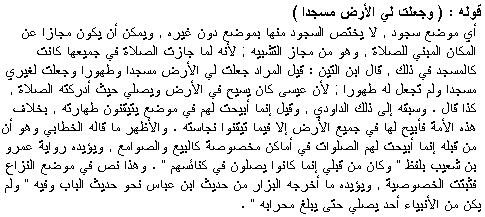
(the earth has been made for me a “masjid“)
means a place for prostration, i.e., prostration is not restricted to any particular place of the earth. It may also be a metaphor of a construction built for prayer. This is due to the fact that once prayer is authorized everywhere on earth it becomes like a mosque for that purpose.Ibn al-Tin said: “The earth has been made for me a masjid and a means of purification” both were given to the Prophet, peace be upon him, while it was only a place for worship for others and was not a means of purification, because Jesus used to walk around and pray whenever prayer was due.
Al-Dawudi said likewise before him. It was also said that they [the previous generations] were authorized to perform prayer in places known for sure to be pure, whereas this ummah is authorized to pray anywhere on earth except in the places known for sure to be impure.
The strongest opinion is that of al-Khattabi who says that earlier nations were authorized to perform prayer in special places like synagogues and churches. This is confirmed by the wording of the narration of Ibn Shu`ayb “And before me people prayed in their churches.”
This is a controversial[?] wording but the specificity was established [??]. This is supported by the narration of al-Bazzar from the hadith of Ibn `Abbas similar to the present hadith which includes “Prophets did not pray until they reached their chamber”.[9]
Before we close this issue, one should realize that verse 17:1 also speaks of “The Sacred Mosque” which is in Makkah around the Ka`bah. Did a building for the mosque exist there in the time of the Prophet? The answer is that the Ka`bah was there but there was no building for the mosque.
This further adds to the argument that the word masjid in this verse refers to a place for performing the prostration and does not imply the presence of a “building” in modern understanding.
The above understanding of the word masjid as a place of worship not a building per se is also well supported by archaeological and historic evidence. Below we present a picture of an early mosque in a place called Besor in Occupied Palestine.[10]

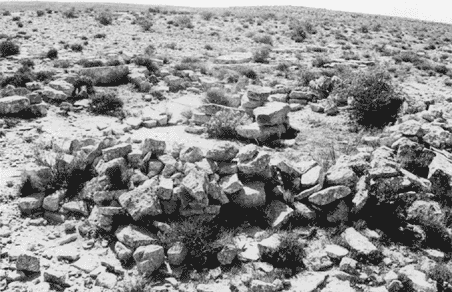
Figure 2: Besor masjid
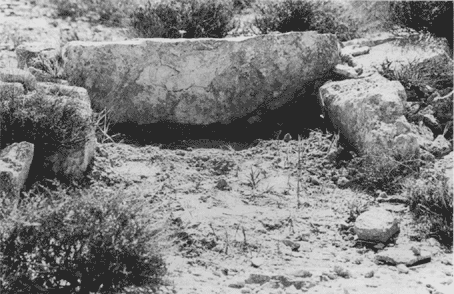
Figure 3: Besor mosque, The Qiblah
Moshe Sharon comments about the Besor mosque. He says:
To the west of the village on the top of the hill, overlooking the valley and the houses of the village, was the threshing floor, and to the south of it a small open mosque with a rectangular mihrab made of 3 blocks of stones [bottom figure]. The mosque was built to a height of probably two layers of stones, no more than 0.5 m., and was almost square, about 3 x 3 m. and could contain no more than 8-10 men at a time.[11]
There are many other examples of early mosques from Negev region that are nothing but a few stones arranged to mark the mihrab.[12,13]
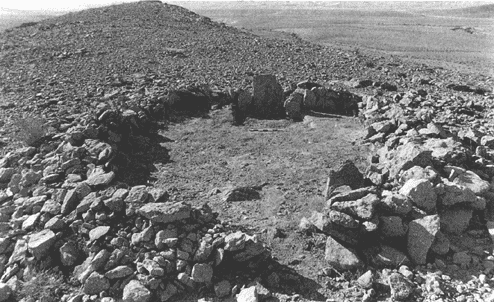
Figure 4: Mosque at Nahal Oded with the upright stone showing the direction of the qibla.
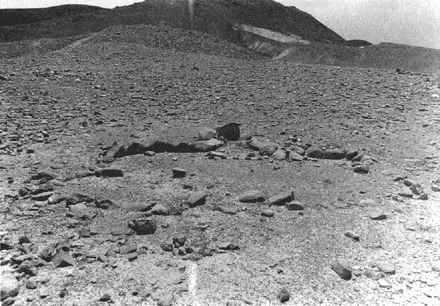
Figure 5: Mosque at Be’er Karkom with a rounded southward-facing mihrab niche.
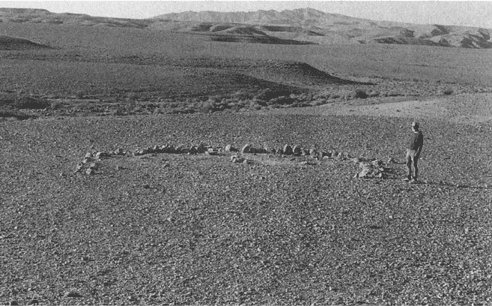
Figure 6: Mosque at Har Oded facing south-southeast.
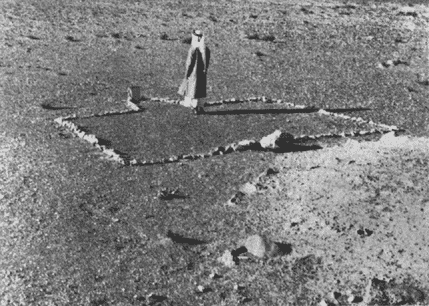
Figure 7: Modern Bedouin open mosque in Transjordan
It is clear from the above pictures that a mosque is simply a place where Muslims prostrate in prayer. It does not need an elaborate building to be called a mosque. The open mosques that we have seen above do exist even today in Middle East and North Africa.
Concerning early mosques, Creswell states:
… their [i.e., Muslims’] architectural resources, before they started in their career of conquest, were barely enough to give expression to their needs. In other words Arabia constituted an almost perfect architectural vacuum… The first mosques in the great hiras, or half nomadic encampments of the conquest,
such as Basra, Kufa and Fustat, were primitive in the extreme, and in Syria the first mosques were churches that had been converted or merely divided: In fact there is no reason for believing that any mosque was built as such in Syria until the time of al-Walid (705-15) or possibly `Abd al-Malik (685-705), for over a generation the Arabs remained quite untouched by any architectural ambitions…[14]
It is worth noting that the Prophet disliked extravagance and impressive architecture in buildings, especially mosques. The relative simplicity of early mosques is in fact a historical example of how the Prophet’s Companions diligently followed his wishes. This is true to a greater extent even today.
3. Al-Masjid Al-Aqsa: A Place Of Prostration For Jews
The Qur’an refers to al-Aqsa as a masjid, a place of prostration. Was this place used for prostration in early times?
Al-Masjid al-Aqsa and the surrounding area (i.e., Dome of the Rock among others) is usually identified with the place where the Temple of Solomon once stood. Bet ha-Miqdash, as the Temple is usually known in Jewish literature, was primarily a place of assembly for the entire people, for purposes of sacrifice, prayer, and thanksgiving. It is in the prayer ritual that prostrations were performed by the priests. Encyclopaedia Judaica provides an interesting account of the prayer ritual by the priests of the Temple.
The priest who had gathered the coals entered the sanctuary first, scattered them over the incense altar, prostrated himself, and departed. Then the priest who was chosen by lot to offer the incense entered, bearing the pan of incense in his hand. He was accompanied by a priest appointed for this task who instructed him in the proper ritual, and he did not offer it until he was told:
“Offer the incense!” The officiating priest waited until the space between the hall and the altar was cleared of people, offered up the incense, prostrated himself, and departed (Tam. 6; Kelim end of ch. 1). During the offering of the incense in the sanctuary, the people used to gather in the azarah for prayer,
and even outside the Temple these times were set aside for prayer (cf. Luke 1:10; Judith 9:1). After the departure of the priest who had offered the incense, all the priests filed into the sanctuary, prostrated themselves, and went out again.[15]
It is interesting to note that the Temple was considered as the only place of prostration by some Rabbis and that they would refuse to completely prostrate outside the Temple in Jerusalem.[16]
The Jewish concept of worship has an extensive vocabulary, out of which hishtahawah, “to prostrate oneself,” is the most frequently used in the Hebrew Bible (86 times).[17]
4. Yet Another Problem!
In the same article, the missionaries express another objection:
In Yusuf Ali’s commentary on this verse we read: “The Farthest Mosque must refer to the site of the Temple of Solomon in Jerusalem…” So, it is interpreted to be not the building itself, but only the site, the location where it had been. I might be wrong, but this seems to be contradicted by a hadith and Muhammad’s understanding that Al-Masjid-ul-Aqs-a is something that is built, not just a location. Al-Masjid-ul-Haram after all was a building.
Sahih Bukhari, Volume 4, Book 55, Number 636:
Narrated Abu Dhaar:
I said, “O Allah’s Apostle! Which mosque was built first?” He replied, “Al-Masjid-ul-Haram.” I asked, “Which (was built) next?” He replied, “Al-Masjid-ul-Aqs-a (i.e. Jerusalem).” I asked, “What was the period in between them?” He replied, “Forty (years).” He then added, “Wherever the time for the prayer comes upon you, perform the prayer, for all the earth is a place of worshipping for you.”
This hadith actually introduces yet another problem. Abraham supposedly (re)built the Kaaba, (and Abraham lived about 2000 BC) and the Temple was built by Solomon in about 958-951 BC, then Muhammad gave another historically false information based on a major confusion about the time when these people lived.
Firstly, we have already shown that the word masjid does not necessarily refer to a building but rather to a location, i.e., the place of prostration. Secondly, the missionaries try to deceive the readers in the above paragraphs. Indeed, they admit the Islamic opinion that Abraham rebuilt the Ka`bah (it was Adam who built it originally according to the Islamic tradition),
but for the unjustified reason, they overlook the Islamic traditions addressing the construction of the farthest mosque, presumably to generate a “contradiction”.
They identify the Farthest Mosque with the Temple of Solomon without further justification and point out an error that they had invented themselves.
Let us for example see what Imam Ibn Hajar says about this hadith in Fath al-Bari:
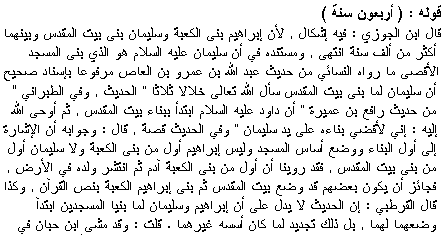
His saying (40 years)
Ibn al-Jawzi said: It raises a problem since Abraham built the Ka`bah and Solomon built Bayt al-Maqdis [another name of al-Masjid al-Aqsa cf. Hebrew Bet ha-Miqdash] and there are 1,000 years between them.His evidence for saying that it is Solomon – peace be upon him – who built the Farthest Mosque is the narration of al-Nasa’i from the hadith of `Abd Allah Ibn `Amr Ibn al-`As attributed to the Prophet with an authentic isnad that “When Solomon built Bayt al-Maqdis he asked God the Most High for three things etc.” and in al-Tabarani from the hadith of Rafi` Ibn `Umayrah that “David – peace be upon him – started building Bayt al-Maqdis but God inspired him:
I shall accomplish its building with Solomon” and the hadith has a story. He [Ibn al-Jawzi] said: “The answer to that is that the mention concerns the first construction and the foundation of the mosque and it is not Abraham who built the Ka`bah for the first time nor is it Solomon who built Bayt al-Maqdis for the first time. Indeed, we have narrated that the first one who built the Ka`bah is Adam.
Then his progeny spread out on earth. Therefore, it is possible that one of them built Bayt al-Maqdis. Later, Abraham (re)built the Ka`bah according to the Qur’an.” Likewise, al-Qurtubi said: The hadith does not indicate that Abraham and Solomon were the first ones to build the two mosques. It was only a renovation of what had been founded by others.[18]
After quoting other opinions, Ibn Hajar insists :
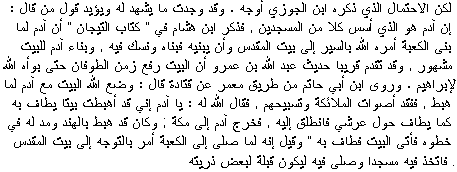
But the possibility mentioned by Ibn al-Jawzi is more pertinent. And I found evidence supporting those who say that it is Adam who founded both mosques. For instance, Ibn Hisham mentioned in “Kitab al-Tijan” that when Adam built the Ka`bah, God ordered him to walk to Bayt al-Maqdis and build it and so he did and offered worship in it.
And the construction of the House [Arabic: al-Bayt, i.e., the Ka`bah] is famous and we have mentioned earlier the hadith of `Abd Allah Ibn `Amr that the House was elevated in the time of the flood until God showed Abraham its location. Ibn Abi Hatim narrated from the way of Ma`mar from Qatadah: God founded the House with Adam when he descended.
But Adam missed the voices of the Angels and their prayers. Therefore, God told him: I sent down a House around which [people] will revolve like it is revolved around my Throne, so set out to it. Adam set out to Makkah –
He had descended in India, and his steps were enlarged until he reached the House and revolved around it. It was also said that when he had prayed at the Ka`bah, he was ordered to set out to Jerusalem where he built a masjid [mosque] and prayed therein so that it became a qiblah to a part of his progeny.[19]
In summary, the verse 17:1 refers to the holy locations in Jerusalem and Makkah because they are blessed regardless of the presence or absence of a building at the time of the heavenly trip of Prophet Muhammad. From an Islamic point of view, evidence has been given by eminent Muslim scholars like Ibn Hajar and Ibn al-Jawzi showing that it was Adam who built both mosques for the first time and that the job of Abraham and Solomon was only a renovation/reconstruction of these sanctuaries.
𝐓𝐨𝐝𝐚𝐲, 𝐰𝐢𝐭𝐡 𝐭𝐡𝐞 𝐩𝐞𝐫𝐦𝐢𝐬𝐬𝐢𝐨𝐧 𝐨𝐟 𝐀𝐥𝐥𝐚𝐡 𝐀𝐥𝐦𝐢𝐠𝐡𝐭𝐲, 𝐈 𝐰𝐚𝐧𝐭𝐞𝐝 𝐭𝐨 𝐬𝐡𝐚𝐫𝐞 𝐰𝐢𝐭𝐡 𝐲𝐨𝐮 𝐚 𝐜𝐨𝐦𝐩𝐫𝐞𝐡𝐞𝐧𝐬𝐢𝐯𝐞 𝐩𝐨𝐬𝐭 𝐜𝐨𝐯𝐞𝐫𝐢𝐧𝐠 𝐭𝐡𝐞 𝐭𝐨𝐩𝐢𝐜 𝐨𝐟 𝐭𝐡𝐞 𝐛𝐨𝐮𝐧𝐝𝐚𝐫𝐢𝐞𝐬 𝐨𝐟 𝐭𝐡𝐞 𝐛𝐥𝐞𝐬𝐬𝐞𝐝 𝐀𝐥-𝐀𝐪𝐬𝐚 𝐌𝐨𝐬𝐪𝐮𝐞.
𝐈𝐧 𝐭𝐡𝐢𝐬 𝐢𝐦𝐚𝐠𝐞, 𝐚𝐧𝐲 𝐦𝐨𝐬𝐪𝐮𝐞 𝐰𝐢𝐭𝐡𝐢𝐧 𝐭𝐡𝐢𝐬 𝐩𝐞𝐫𝐢𝐦𝐞𝐭𝐞𝐫, 𝐢𝐧 𝐚𝐝𝐝𝐢𝐭𝐢𝐨𝐧 𝐭𝐨 𝐭𝐡𝐞 𝐥𝐚𝐧𝐝 𝐢𝐭𝐬𝐞𝐥𝐟, 𝐢𝐬 𝐜𝐨𝐥𝐥𝐞𝐜𝐭𝐢𝐯𝐞𝐥𝐲 𝐫𝐞𝐟𝐞𝐫𝐫𝐞𝐝 𝐭𝐨 𝐚𝐬 𝐭𝐡𝐞 𝐛𝐥𝐞𝐬𝐬𝐞𝐝 𝐀𝐥-𝐀𝐪𝐬𝐚 𝐌𝐨𝐬𝐪𝐮𝐞.
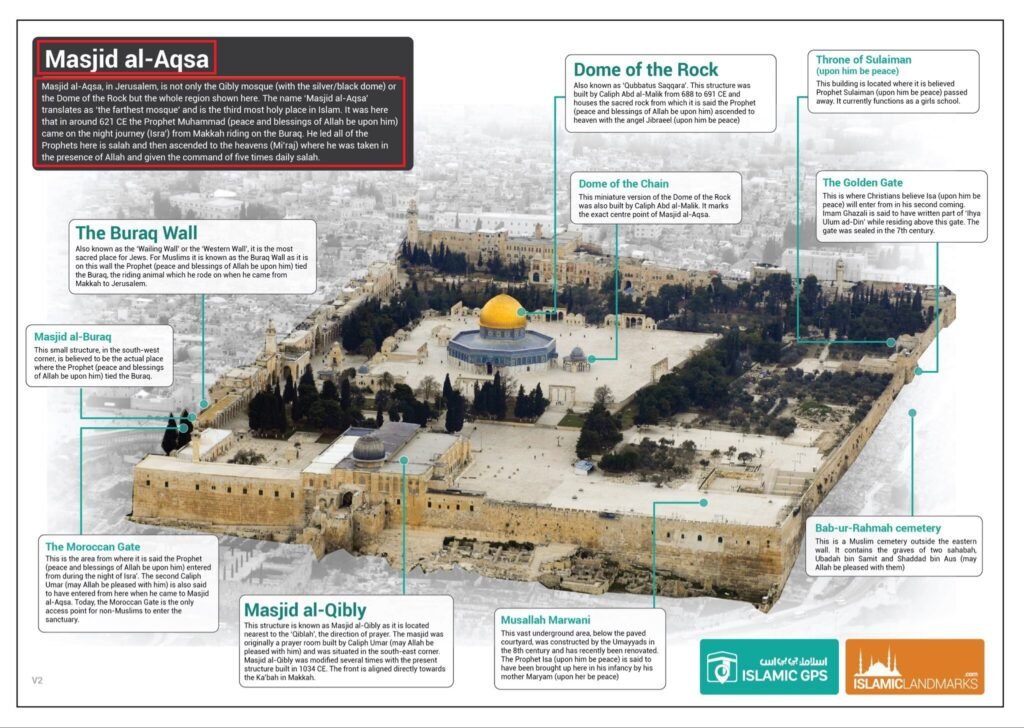
𝐓𝐨 𝐜𝐥𝐚𝐫𝐢𝐟𝐲, 𝐚𝐥𝐥 𝐭𝐡𝐞 𝐥𝐚𝐧𝐝 𝐬𝐮𝐫𝐫𝐨𝐮𝐧𝐝𝐞𝐝 𝐛𝐲 𝐭𝐡𝐢𝐬 𝐨𝐮𝐭𝐞𝐫 𝐰𝐚𝐥𝐥 𝐚𝐧𝐝 𝐚𝐥𝐥 𝐭𝐡𝐞 𝐦𝐨𝐬𝐪𝐮𝐞𝐬 𝐰𝐢𝐭𝐡𝐢𝐧 𝐭𝐡𝐢𝐬 𝐰𝐚𝐥𝐥 𝐚𝐫𝐞 𝐜𝐚𝐥𝐥𝐞𝐝 𝐭𝐡𝐞 𝐛𝐥𝐞𝐬𝐬𝐞𝐝 𝐀𝐥-𝐀𝐪𝐬𝐚 𝐌𝐨𝐬𝐪𝐮𝐞. 𝐒𝐨𝐦𝐞 𝐨𝐩𝐩𝐨𝐧𝐞𝐧𝐭𝐬 𝐨𝐟 𝐈𝐬𝐥𝐚𝐦 𝐪𝐮𝐞𝐬𝐭𝐢𝐨𝐧 𝐡𝐨𝐰 𝐌𝐮𝐬𝐥𝐢𝐦𝐬 𝐜𝐥𝐚𝐢𝐦 𝐨𝐰𝐧𝐞𝐫𝐬𝐡𝐢𝐩 𝐨𝐟 𝐀𝐥-𝐀𝐪𝐬𝐚 𝐌𝐨𝐬𝐪𝐮𝐞 (𝐁𝐚𝐢𝐭𝐮𝐥 𝐀𝐥- 𝐌𝐮𝐪𝐚𝐝𝐝𝐚𝐬), 𝐰𝐡𝐢𝐜𝐡 𝐢𝐧𝐜𝐥𝐮𝐝𝐞𝐬 𝐚𝐥𝐥 𝐭𝐡𝐞𝐬𝐞 𝐦𝐨𝐬𝐪𝐮𝐞𝐬 𝐢𝐧𝐬𝐢𝐝𝐞 𝐢𝐭, 𝐚𝐬 𝐦𝐞𝐧𝐭𝐢𝐨𝐧𝐞𝐝 𝐢𝐧 𝐭𝐡𝐞 𝐆𝐥𝐨𝐫𝐢𝐨𝐮𝐬 𝐇𝐨𝐥𝐲 𝐐𝐮𝐫𝐚𝐧.
𝐓𝐡𝐞𝐲 𝐚𝐫𝐠𝐮𝐞 𝐭𝐡𝐚𝐭 𝐬𝐨𝐦𝐞 𝐨𝐟 𝐭𝐡𝐞𝐬𝐞 𝐦𝐨𝐬𝐪𝐮𝐞 𝐬𝐭𝐫𝐮𝐜𝐭𝐮𝐫𝐞𝐬 𝐰𝐞𝐫𝐞 𝐛𝐮𝐢𝐥𝐭 𝐝𝐮𝐫𝐢𝐧𝐠 𝐭𝐡𝐞 𝐭𝐢𝐦𝐞 𝐨𝐟 𝐭𝐡𝐞 𝐫𝐢𝐠𝐡𝐭𝐥𝐲 𝐠𝐮𝐢𝐝𝐞𝐝 𝐂𝐚𝐥𝐢𝐩𝐡 𝐔𝐦𝐚𝐫 𝐢𝐛𝐧 𝐚𝐥-𝐊𝐡𝐚𝐭𝐭𝐚𝐛 𝐚𝐧𝐝 𝐰𝐞𝐫𝐞 𝐧𝐨𝐭 𝐩𝐫𝐞𝐬𝐞𝐧𝐭 𝐝𝐮𝐫𝐢𝐧𝐠 𝐭𝐡𝐞 𝐭𝐢𝐦𝐞 𝐨𝐟 𝐭𝐡𝐞 𝐏𝐫𝐨𝐩𝐡𝐞𝐭.
𝐓𝐡𝐞 𝐬𝐢𝐦𝐩𝐥𝐞 𝐚𝐧𝐬𝐰𝐞𝐫 𝐭𝐨 𝐭𝐡𝐢𝐬 𝐥𝐢𝐞𝐬 𝐢𝐧 𝐮𝐧𝐝𝐞𝐫𝐬𝐭𝐚𝐧𝐝𝐢𝐧𝐠 𝐭𝐡𝐚𝐭 𝐭𝐡𝐞 𝐭𝐞𝐫𝐦 ‘𝐦𝐨𝐬𝐪𝐮𝐞’ 𝐢𝐧 𝐭𝐡𝐞 𝐭𝐞𝐫𝐦𝐢𝐧𝐨𝐥𝐨𝐠𝐲 𝐨𝐟 𝐭𝐡𝐞 𝐐𝐮𝐫𝐚𝐧 𝐫𝐞𝐟𝐞𝐫𝐬 𝐭𝐨 𝐭𝐡𝐞 𝐥𝐚𝐧𝐝 𝐢𝐭𝐬𝐞𝐥𝐟, 𝐧𝐨𝐭 𝐣𝐮𝐬𝐭 𝐭𝐡𝐞 𝐬𝐭𝐫𝐮𝐜𝐭𝐮𝐫𝐞𝐬.
𝐇𝐞𝐧𝐜𝐞, 𝐭𝐡𝐞 𝐏𝐫𝐨𝐩𝐡𝐞𝐭, 𝐩𝐞𝐚𝐜𝐞 𝐛𝐞 𝐮𝐩𝐨𝐧 𝐡𝐢𝐦, 𝐬𝐚𝐢𝐝, ‘𝐓𝐡𝐞 𝐞𝐚𝐫𝐭𝐡 𝐡𝐚𝐬 𝐛𝐞𝐞𝐧 𝐦𝐚𝐝𝐞 𝐟𝐨𝐫 𝐦𝐞 𝐚 𝐩𝐥𝐚𝐜𝐞 𝐨𝐟 𝐰𝐨𝐫𝐬𝐡𝐢𝐩 𝐚𝐧𝐝 𝐩𝐮𝐫𝐢𝐟𝐢𝐜𝐚𝐭𝐢𝐨𝐧.’ 𝐓𝐡𝐢𝐬 𝐚𝐥𝐬𝐨 𝐢𝐧𝐝𝐢𝐜𝐚𝐭𝐞𝐬 𝐭𝐡𝐚𝐭 𝐭𝐡𝐞 𝐥𝐚𝐧𝐝 𝐢𝐭𝐬𝐞𝐥𝐟, 𝐰𝐢𝐭𝐡𝐨𝐮𝐭 𝐬𝐭𝐫𝐮𝐜𝐭𝐮𝐫𝐞𝐬, 𝐜𝐚𝐧 𝐛𝐞 𝐜𝐚𝐥𝐥𝐞𝐝 𝐚 𝐦𝐨𝐬𝐪𝐮𝐞.
𝐓𝐡𝐞𝐫𝐞𝐟𝐨𝐫𝐞, 𝐭𝐡𝐞 𝐐𝐮𝐫𝐚𝐧 𝐝𝐢𝐝 𝐧𝐨𝐭 𝐦𝐚𝐤𝐞 𝐚 𝐦𝐢𝐬𝐭𝐚𝐤𝐞, 𝐚𝐧𝐝 𝐭𝐡𝐞 𝐦𝐢𝐬𝐮𝐧𝐝𝐞𝐫𝐬𝐭𝐚𝐧𝐝𝐢𝐧𝐠 𝐥𝐢𝐞𝐬 𝐰𝐢𝐭𝐡 𝐭𝐡𝐞 𝐞𝐧𝐞𝐦𝐢𝐞𝐬 𝐨𝐟 𝐈𝐬𝐥𝐚𝐦. 𝐌𝐚𝐲 𝐀𝐥𝐥𝐚𝐡 𝐠𝐮𝐢𝐝𝐞 𝐮𝐬 𝐚𝐧𝐝 𝐭𝐡𝐞𝐦 𝐭𝐨 𝐰𝐡𝐚𝐭 𝐇𝐞 𝐥𝐨𝐯𝐞𝐬 𝐚𝐧𝐝 𝐢𝐬 𝐩𝐥𝐞𝐚𝐬𝐞𝐝 𝐰𝐢𝐭𝐡.
𝐃𝐨𝐧’𝐭 𝐟𝐨𝐫𝐠𝐞𝐭 𝐭𝐨 𝐬𝐡𝐚𝐫𝐞 𝐭𝐡𝐢𝐬 𝐩𝐨𝐬𝐭 𝐰𝐢𝐭𝐡 𝐠𝐫𝐞𝐚𝐭 𝐬𝐭𝐫𝐞𝐧𝐠𝐭𝐡.”
5. Conclusions
The word masjid from a linguistic point of view refers to a place of prostration without any religious distinction. From a legal point of view the word masjid in shari`ah constitutes every place on earth that is fit for prostration, whether or not it is a building.
The verse 17:1 may very well refer to the holy locations in Jerusalem and Makkah because they are blessed regardless of the presence or absence of a building at the time of the heavenly trip of Prophet Muhammad from Makkah to Jerusalem to the Heavens. From an Islamic point of view, evidence has been given by eminent Muslim scholars like Ibn Hajar and Ibn al-Jawzi who have discussed the issue.
They have shown that it was Adam who built both mosques for the first time and that the duty of Abraham and Solomon was only a renovation/reconstruction of these sanctuaries.
And Allah knows best!
Further Reading
Arda Wiraz Namag (Iranian “Divina Commedia”) And The Prophet’s(P) Night Journey
Appendix: Who Turned The Temple Mount Into A Garbage Dump?
Let’s now deal with some side issues. The Christian missionaries tell us that when the Muslims conquered Jerusalem they found the Temple Mount filled with garbage:
“When the Arabs conquered Jerusalem they found the Temple Mount abandoned and filled with refuse. … `Umar ordered it cleaned and performed a prayer there. The sanctuary [the Dome of the Rock] … was built by Caliph `Abd al-Malik ibn Marwan around 72/691.”
Two questions now arise, who abandoned the Temple Mount and why was it filled with rubbish? The facts become clearer when we actually fill in the blanks “…” in the Christian missionaries’ quotation:
When the Arabs conquered Jerusalem they found the Temple Mount abandoned and filled with refuse. The abandonment of the Temple site was in accordance with Jesus’ prophecy that not a stone would be left standing on another. `Umar ordered it cleaned and performed a prayer there.[20]
So, it was the Christians who abandoned the Temple some 600 years before the Muslims entered it. But who used the Holy place as a rubbish dump?
Ever since the Persian occupation, when the Jews had resumed worship on the platform, the Christians had used the place as the city rubbish dump. When `Umar reached the old ruined gates of the Temple, says the Muslim historian Mujir al-Din, he was horrified to see the filth, “which was then all about the holy sanctuary, had settled on the steps of the gates so that it even came out into the streets in which the gate opened, and it had accumulated so greatly as almost to reach up the ceiling of the gateway.”
The only way to get up to the platform was to crawl on hands and knees. Sophronius went first and the Muslims struggled up behind. When they arrived at the top, the Muslims must have gazed appalled at the vast and desolate expanse of Herod’s platform, still covered with piles of fallen masonry and garbage.[21]
It was the Christians! The Christian attitude towards Jerusalem can be understood by reading the New Testament. Paul’s Epistles and the Book of Revelation may have defined a theological framework for the attitude towards Jerusalem, but the two synoptic Gospels of Luke (19:42-44) and Matthew did more than that. They also provided guidelines for political or quasi political actions after Christianity became the officially established religion of the Roman Empire.
The Gospels relate how Jesus rebuked his disciples when they admired the Temple’s beauty from the Mount of Olives: “His disciples came to point out to him the buildings of the Temple. But he answered them, ‘You see all these, do you not? Truly, I say to you, there will not be left any stone upon another.'” (Matthew 24:1-2).
Art historians such as Nuseibah and Grabar have reached a similar conclusion concerning the Christian attitude toward the Temple Mount:
More importantly, not only was the Haram left barren, but that very barrenness was given the Christian significance of fulfilling Christ’s prophecy, “There will not be left here one stone upon another that shall not be thrown down” (Mark 13:2). The ruins of the Jewish Temple and whatever else had been there were to remains as signs of the triumph of Christianity.[22]
Thus the Christians preferred to leave Temple as it was after its destruction; it was left abandoned and became a place for dumping city garbage. It would not be out of place to cite the attitude towards Jerusalem in the early Christian literature. We will take examples from the writings of John Chrysostom and Athanasius, both of their contemporaries.
John Chrysostom of Antioch was the founding father of Christian anti-semitism, whose writing against Jews are extremely vitriolic and of bad taste (no wonder the Christian Church honoured him!).[23] He lived during the period (4th century CE) when Christian eschatology was being linked to Jerusalem or (euphemistically) the Temple Mount.
In the wake of Jewish proselytizing efforts, which he feared would empty the churches, Chrysostom vented unbridled wrath against the Jews of Antioch, levelling various accusations against Jews and Judaism.
He censured the Jews for celebrating Passover outside Jerusalem, thereby disobeying their own commandments.[24] Above all, he claimed that Jerusalem’s destruction testified the truth of Christianity. Jerusalem has been in ruins and lost to the Jews for three hundred years; why should they await a change?[25]
They tried to rebuild the Temple three times – in the time of Hadrian (Bar Kochba revolt), Constantine (an unknown attempt) and Julian. All the attempts failed. It should make amply clear to the Jews that their status will not change. It is true that the prophets referred to an end to exile, but they did not mean the present exile, which is eternal.[26] In this way, Jerusalem’s status came to be identified by the Christians with the fate of Jews; the latter’s final, eternal defeat.
Like his contemporary John Chrysostom, Athanasius was involved in anti-Jewish polemics but not as bitterly as the former.[27] Athanasius thought that the incorporation of Jerusalem into Christian Empire provides the proof of new religion’s truth. According to Jesus’ prophecy, the Holy City as well as Temple have been taken from them forever.
The Christian Jerusalem, before of the advent of Islam, had undergone subtle developments. The Christians had appropriated a body of Jewish traditions concerning the Temple Mount (some of them mentioned in the New Testament) and were now applied to the Church of Holy Sepulchre and Church of Resurrection.
The process of “consecration” of Jerusalem and making it into a Christian city met with little opposition; the pagans had no opposition, while the Jews had not been permitted to reside in Jerusalem since the time of Hadrian (the Bar Kochba revolt). And as expected the Temple Mount was left in the state of pile of fallen masonry and rubbish.
It was Islam that restored the sanctity of Temple Mount and made it a place of prostration and prayer.
𝐍𝐨𝐭𝐞
To Christians who criticize The Night Journey of our Beloved Prophet Muhammed peace be upon him:



References
[1] `Abdallah `Abd al-Fadi, Is The Qur’an Infallible?, 1995, Light of Life: Villach (Austria), p. 271.
[2] A. Duncan, The Noble Sanctuary: Portrait Of A Holy Place In Arab Jerusalem, 1972, Middle East Archive: London (UK), p. 24.
[3] Badr al-Din bin Muhammad bin Bahadir al-Zarkashi, I`lam Al-Sajid Bi-Ahkam Al-Masajid, 1995, Dar al-Kutub al-`Ilmiyyah, Beirut (Lebanon), p. 13.
[4] N. Robinson, Discovering The Qur’an: A Contemporary Approach To A Veiled Text, 1996, SCM Press Ltd.: London, p. 192.
[5] See for example the recent work of Heribert Busse, “The Destruction Of The Temple And Its Reconstruction In The Light Of Muslim Exegesis Of Sura 17:2-8”, Jerusalem Studies In Arabic And Islam, 1996, Volume 20, p. 1.
[6] Al-Zarkashi, I`lam Al-Sajid Bi-Ahkam Al-Masajid, op. cit., pp. 13-14.
[7] ibid., p. 14.
[8] Sahih al-Bukhari, available online.
[9] Ibn Hajar al-`Asqalani, Fath al-Bari available online.
[10] M. Sharon, Corpus Inscriptionum Arabicarium Palaestinae, 1999, Volume II, Brill: Leiden, see plates P29 and P30.
[11] ibid., p. 172.
[12] G. Avni, “Early Mosques In The Negev Highlands: New Archaeological Evidence On Islamic Penetration Of Southern Palestine”, Bulletin Of The American Schools Of Oriental Research, 1994, Volume 294, pp. 83-100. All the pictures are taken from here.
[13] U. Avner & J. Magness, “Early Islamic Settlement In The Southern Negev”, Bulletin Of The American Schools Of Oriental Research, 1998, Volume 310, pp. 39-57. This articles throws further light on an early Islamic open mosque and a settlement.
[14] K. A. C. Creswell, A Short Account Of Early Muslim Architecture, 1968, Librairie Du Liban, Beirut, pp. 15-16.
[15] “Temple”, Encyclopaedia Judaica (CD-ROM Edition), 1997, Judaica Multimedia (Israel) Limited.
[16] “Tahnum”, ibid.
[17] “Worship”, ibid.
[18] See ref. 4.
[19] ibid.
[20] “Dome Of The Rock” in C. Glassé, The Concise Encyclopaedia Of Islam, 1989, Stacey International: London, p. 102.
[21] K. Armstrong, Jerusalem: One City, Three Faiths, 1997, Ballantine Books: New York, p. 229.
[22] S. Nuseibah & Oleg Grabar, The Dome Of The Rock, 1996, Thames and Hudson: London (UK), p. 35.
[23] St. John Chrysostom (translated by P. W. Harkins), Discourses Against Judaizing Christians, 1979, The Catholic University Of America Press: Washington, DC.
[24] ibid., See discourse IV: 4.9, 5.1-3, 6.1-5.
[25] ibid., See discourse V: 3.13-15; also 5.10
[26] ibid., See discourse V: 4.5.
[27] St. Athanasius (translated by C. S. M. V.), The Incarnation Of The Word Of God: Being The Treatise Of St. Athanasius De Incarnatione Verbi Dei, 1944, The Centenary Press: London (UK), see the chapter VI, “Refutation Of The Jews”, p. 64.
What Is the Difference Between al-Aqsa and the Dome of the Rock?
Al-Isra, The Night Journey” With PROOF From Christian Sources
Did Islam Copy From Zoroastrianism?
Why is Jerusalem (Quds) important for Jews and Christians?
Did Masjid al-Aqsa exist in Quds when the Prophet (pbuh) lived?
Arda Wiraz Namag (Iranian “Divina Commedia”) And The Prophet’s Night Journey
Refuting the Claim that Miraj was Plagiarized from the Zoroastrian Book- Arda Viraz or ARDĀ WĪRĀZ
Paul The False Apostle of Satan
Why Do Muslims Pray 5 Times a Day?
How was prayer first prescribed?
Islam awareness